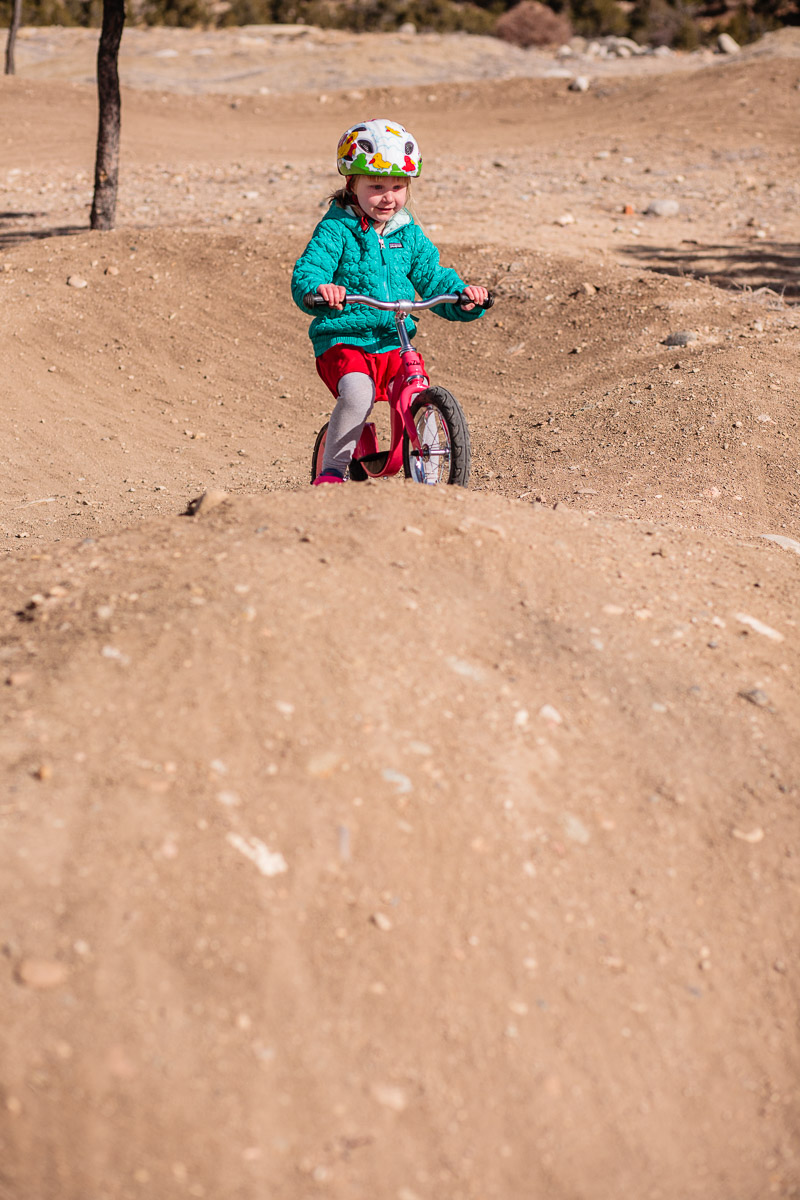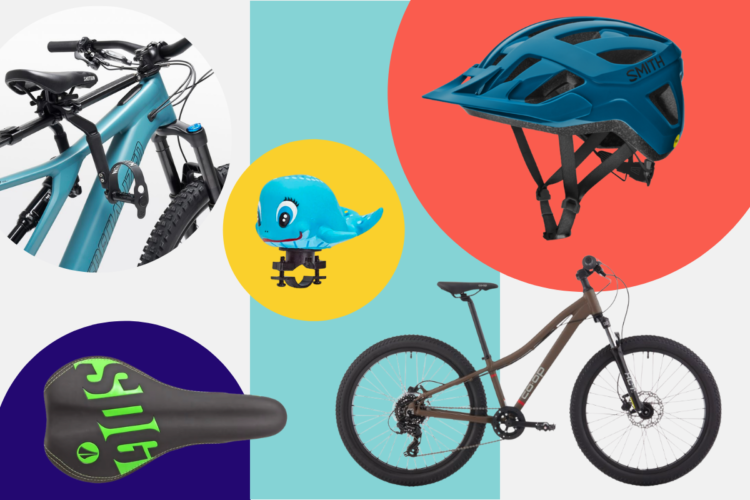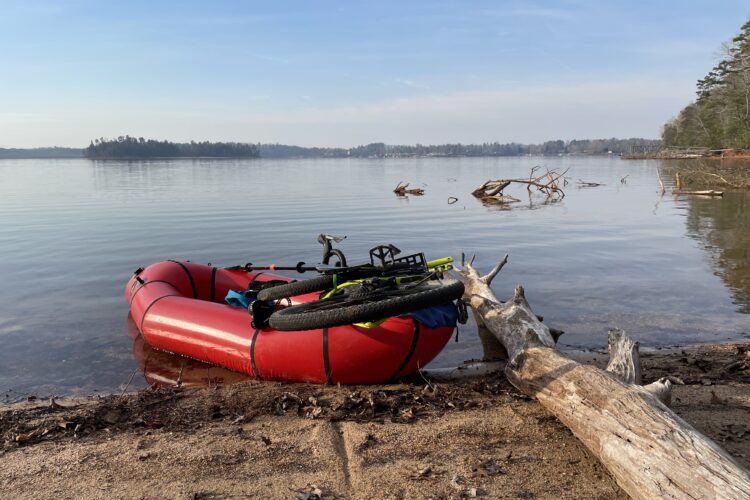You are a mountain biker. You ride as often as “real life” allows. Initially, “real life” limits are things like school, job, finances, and proximity to trails. If you’re lucky, you add a significant other/spouse to your life. If you’re really lucky, that person loves to ride and you have a life-long riding partner. After a few years of weekends and vacations spent on the trails, you’ve decided it’s time for a baby biker. “Real life” laughs as it reigns you in, while you figure out how to survive, much less keep riding.
After many months of taking turns with your spouse getting out for rides, occasionally getting a sitter while you ride together, you realize you need to turn this baby into a biker ASAP… but how? As the mother of three grown children, “Nana” of seven grandchildren (ages 3 to 14), and a lifelong cyclist, I offer the following suggestions:
Make Riding a Natural Part of Family Life:
Though it will be about six months to a year before you can start pulling your baby in a trailer you can still include bikes as a part of your family culture (babycenter.com says a baby should be “12 months old” and quotes the American Academy of Pediatrics in stating that the child must be able to “sit up steadily and she needs to have a helmet that fits properly”). She will see you riding, she can “help” you clean your bikes, you can read bike-related picture books, and attend bike events like races and festivals. Just having parents who visibly love riding is huge in raising a future mountain biker.
Be a Role Model:
Keep in mind that you are the rider you want your child to become. Though it should go without saying, I’ll say it anyway: wear a helmet, practice courteous trail etiquette, obey the rules of the road, and display a positive attitude. You are your child’s first and best teacher, and they learn by watching.
It Actually IS About the Bike:
Though riding in a trailer, pulled by you, is fun and quite practical for many situations (see Taking the Kids Ice Biking: Adventures While Bike Commuting During a Wisconsin Winter and How to Fat Bike in the Snow with Kiddos ), kids love to actually ride. One of the best things to happen to cycling is the advent of balance bikes!

All photos by Scott Anderson except where noted.

There are loads of options available to choose from, and a toddler can master riding as soon as her feet can touch the ground while she is seated on the bike. Sidewalks, park paths, singletrack, and pumptracks are all fair game. Another great way to start a tiny rider is on a tandem with you. I purchased a Raleigh mountain tandem when our first grandchild was born 14 years ago. It was dubbed the “Family Tandem” because it was adaptable for nearly anyone to captain and could be set up for stokers aged 15 months to adult. We rigged the stoker cockpit with a backrest with straps and a child stoker kit (see precisiontandems.com). Emma started riding when she was 15 months old.


We had many Emma/Nana adventures until Emma’s little sister Zoe begged to ride with us. Emma, at age 4, was still too young to ride on our rural Northern Wisconsin roads, so we added a Burley Piccolo to the tandem.

Now, Zoe could take the stoker seat, while Emma pedaled at her own pace and practiced shifting on the Piccolo. (A new benefit of the Piccolo is the option of converting it to a child’s bike – see Burley Plus). After stoking the tandem and riding the Piccolo, Emma had no problem transitioning to her own bike at age 5.

That first bike was NOT the right choice for riding anything but paved park paths, however. But it is possible to find kids’ mountain bikes that don’t cost a fortune. Back in 2006, we settled on 20″ Marin Hidden Canyon for Emma & Zoe’s first mountain bikes.


If I were buying a 20″ mountain bike now, I’d take a close look at the singlespeed Cleary Owl, which weighs in at a mere 19.1 lbs. and costs $335, compared to the current $419 for the Hidden Canyon. Weight has long been an issue with kid’s bikes, but cost is harder to justify when a kid outgrows her bike every year or two.


As long as you get a bike with real parts that can be fixed and–most importantly–fits your child, she will be excited to ride with you.
Make it FUN:
If you truly want your child to love riding, you need to carefully plan age-appropriate rides. If you are patient in the early years, you will have a skilled, enthusiastic riding partner (who will likely outride you one day!) forever.

To choose appropriate outings, start with your child’s age and skill level, then apply the following:
a. Destination – what will you do there?
b. Duration
c. Difficulty
Examples:
E1. 15-month-old Emma – Tandem stoker
a. 1/4 mile to the creek – throw sticks in creek b. 30 minutes total time c. paved road
E2. 2 1/2-year-old Emma – Tandem stoker
a. 3-mile ride to the beach (6-mile round trip) – picnic and swimming b. 3 hours total time c. paved roads
E3. 2-year-old Zoe (stoker) and 4-year-old Emma (Piccolo)
a. 4 miles – pick wildflowers, eat cookies b. 2 hours c. combo of paved, gravel, and wide grassy trail
E4. 3-year-old Wilder and 5-year-old Elle – Balance bikes
a. Pumptrack session b. As long as they are saying “one more time.” c. Packed dirt pumptrack
E5. 5-year-old Zoe and 8-year-old Emma
a. 3-mile singletrack ride/snack midpoint lake swim after b. 1.5 hours riding–unlimited swim time c. Flowy, packed singlettrack
E6. 8-year-old Zoe and 11-year-old Emma
a. Mountain Bike Festival: many trail rides, skill clinics, food stations, locating punch card stations, door prize drawings, and staying at cabin with Nana and GrandScott + kayaking b. 2 days for Zoe, 2.5 days for Emma c. Variety of CAMBA singletrack segments

Skills Acquisition and Risk Assessment:
Skills acquisition comes with exposure, repetition, and confidence, but it still needs to be fun!





Let your child have many opportunities to experiment with reasonable risk. Research has shown that “when children are given a chance to engage freely in adventurous play they quickly learn to assess their own skills and match them to the demands of the environment. Such children ask themselves—consciously or unconsciously—“how high can I climb” or “is this log across the creek strong enough to support me?” They become savvy about themselves and their environment. Children who are confident about taking chances rebound well when things don’t work out at first. They are resilient and will try again and again until they master a situation that challenges them—or wisely avoid it, if that seems best. ” (Source: http://www.communityplaythings.com/resources/articles/2013/the-role-of-risk-in-play-and-learning)
It is important that children not be pushed to do things they aren’t ready for and to be allowed to take risks that may involve failure. The ability to self-assess risk is a huge life skill; your job is to establish acceptable risk parameters, then let your child go for it.


Never promise that she won’t get hurt, but be prepared with a squirt of water and a cheery, “Are you OK? You’re a tough rider,” type of comment.

Do carry a first aid kit; injuries can happen! Don’t underestimate girls – they are every bit as competent as boys!

Make Sure They’re Comfortable:
Bike shorts are worth the cost, even for the littlest riders. Beyond that, make sure that her helmet is adjusted correctly and that you have extra clothes in case of changing weather conditions. Food and drink are fundamental parts of activity with kids. Healthy food is great, but the power of a few M&Ms, homemade cookies, or stopping for an ice cream cone is amazing. Always know where a bathroom is and teach her how to pee in the woods!
If you make riding a natural part of family life, are a positive role model, provide a decent, well-fitting bike, encourage skills acquisition, and make rides comfortable and FUN, you will likely find yourself with one or more lifelong riding buddies.

Photo: Megan Peterson
Eventually, they will even take off without you and you’ll have to ask if you can tag along.
Your turn: If you have kids, do they join you on your MTB rides?




















12 Comments
Sep 10, 2017
Oh, and young girls ride better than young boys. They mature faster and are more balanced and less "wham and slam".
Sep 11, 2017
May 2, 2015
May 1, 2015
Apr 29, 2017
Jul 26, 2018
May 2, 2015
May 4, 2015
-GT
Apr 30, 2015
He's totally hard core now.
Apr 30, 2015
Apr 30, 2015
Apr 30, 2015